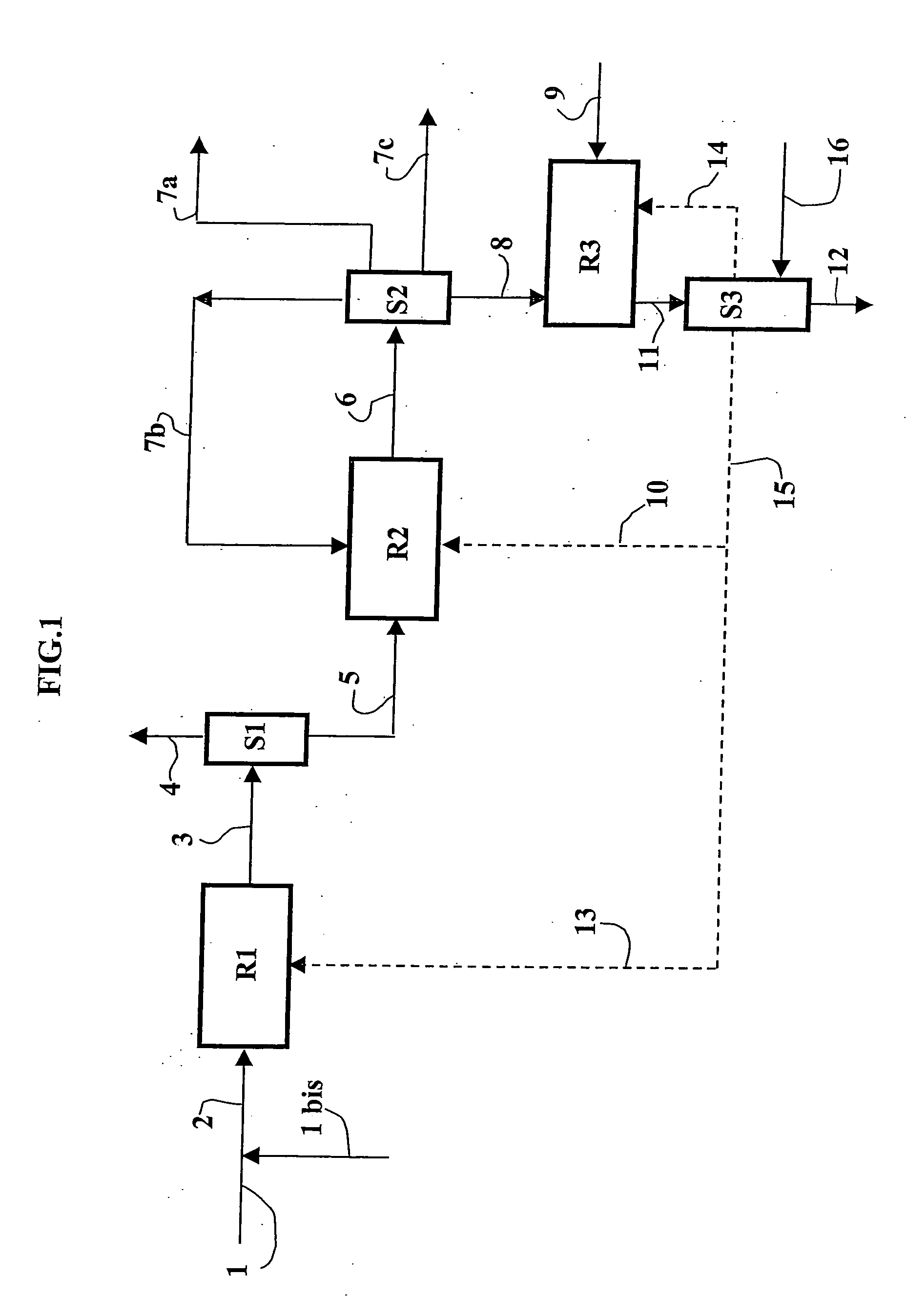Process for multistage conversion of a charge comprising olefins with four, five or more carbon atoms, with the aim of producing propylene
a technology of olefins and carbon atoms, which is applied in the direction of hydrocarbon by hydrocarbon cracking, chemistry apparatus and processes, organic chemistry, etc., can solve the problems of low yield of latter, thermal cracking, and formation of light compounds which are poorly valorizable, and achieve the effect of improving the propylene to ethylene ratio of steam crackers
- Summary
- Abstract
- Description
- Claims
- Application Information
AI Technical Summary
Benefits of technology
Problems solved by technology
Method used
Image
Examples
example 1
According to the Invention
[0192] The following example of application in a pilot plant illustrates the invention without limiting its scope.
[0193] A C4 cut from steam cracking, to which a C4 / C5 cut recycled from the cracking stage has been added, is used as the feed for oligomerization. Said cut undergoes selective hydrogenation beforehand and removal of the isobutene that it contained initially. The compositions (as percentages by weight) of the charge and of the effluent from oligomerization are shown in Table 1.
[0194] The operating conditions of the oligomerization zone are as follows: pressure 5.5 MPa, temperature 220° C., SV=1 h−1. The catalyst used is a type MFI zeolite with an Si / Al ratio of 48. It is used in the form of spheres with average diameter of 2 mm. The oligomers produced, which mainly contain C8 olefinic oligomers, and C12 in smaller quantities, are fed to the cracking zone, which has the following operating conditions: [0195] pressure: 0.2 MPa, [0196] temperatu...
example 2
Oligomerization of Various Olefinic Charges
[0204] Two C4 and C5 olefinic cuts are available (which may for example come from an FCC), for which a preliminary oligomerization is carried out: either of the C4 cut alone, or of the C4 cut mixed with the C5 cut (co-oligomerization). The effluents from these oligomerizations will be used in Examples 3 and 4 below.
[0205] The conditions of oligomerization are identical to those in Example 1.
[0206] The composition of the charges and of the effluents from oligomerization is shown in Table 3:
TABLE 3Charge or EffluentEffluent fromfromEffluent fromoligomerizationoligomerizationC4 cutC5 cutoligomerizationof the (C4 +kg / h(charge)(charge)of the C4 cutC5) cutC4 paraffins7649078717871Isobutene125066Butene-120250103106Butene-250690254324C5 paraffins0759807844C5 olefins0983802103C6+ cut (1)00663314048Total14867174351486732302
(1) A Cn+cut comprises, by definition, the cuts having at least n carbon atoms.
example 3
According to the Invention
[0207] The C5+ cut obtained from oligomerization (co-oligomerization) of the (C4+C5) cut according to Example 2 (last column of Table 3) is cracked catalytically in the same conditions as in Example 1. The cracking yields, expressed as in the case in Example 1, as wt. % relative to the olefinic cut of the C4+C5 charge, except isobutene, are shown in Table 4:
TABLE 4Yields, wt. %Cracking outletH20.39CH41.15C2H45.20C2H62.44C3H628.73C3H83.35C4 / C5 paraffins5.65Isobutene11.11C4 / C5 olefins except isobutene37.40Gasoline4.60Total100.0
[0208] If the cracking reactor, for example in an FCC unit or a fixed-bed or moving-bed unit, or the cracked gas compressor, or the gas treatment unit are of limited capacity, it is possible to use the C6+ cut obtained from oligomerization, rather than the C5+ cut obtained from oligomerization, as the feed for cracking, to reduce the flow rate of cracked oligomers, with a relatively small loss of propylene.
[0209] If the charge of ol...
PUM
| Property | Measurement | Unit |
|---|---|---|
| wt. % | aaaaa | aaaaa |
| mass ratio | aaaaa | aaaaa |
| mass ratio | aaaaa | aaaaa |
Abstract
Description
Claims
Application Information
 Login to View More
Login to View More - R&D
- Intellectual Property
- Life Sciences
- Materials
- Tech Scout
- Unparalleled Data Quality
- Higher Quality Content
- 60% Fewer Hallucinations
Browse by: Latest US Patents, China's latest patents, Technical Efficacy Thesaurus, Application Domain, Technology Topic, Popular Technical Reports.
© 2025 PatSnap. All rights reserved.Legal|Privacy policy|Modern Slavery Act Transparency Statement|Sitemap|About US| Contact US: help@patsnap.com



